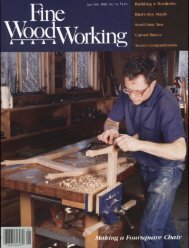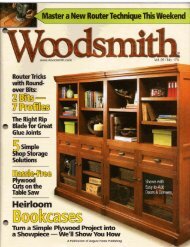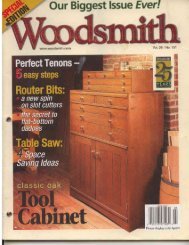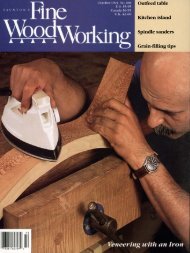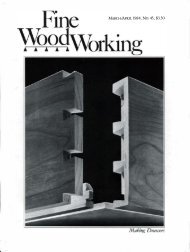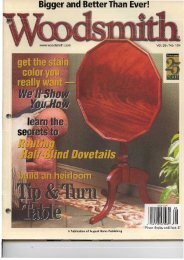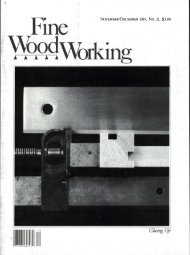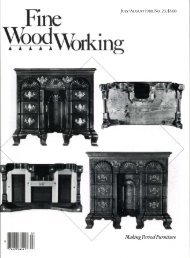orking - MetosExpo - Free
orking - MetosExpo - Free
orking - MetosExpo - Free
Create successful ePaper yourself
Turn your PDF publications into a flip-book with our unique Google optimized e-Paper software.
LETTERS ______________________________________ _<br />
I would like to offer a couple of offbeat sources for hardwoods<br />
that may have escaped the attention of other woodworkers.<br />
Near here is a veneer mill that makes face veneer and<br />
assembles it to order for the many furniture factories in the<br />
East. As you know, fine veneer is cut from logs, whole or half,<br />
and there is a " remainder" of the log, which has served as the<br />
holding surface, when the knife has cut as close to the holding<br />
mechanism as it can safely go . Confusingly, this remainder is<br />
called the flitch, just as is the bundle of veneer cut from it.<br />
These flitches become waste material to the mill, and are<br />
stacked outside until disposed of, in whatever way they can<br />
be. They are sold to whoever comes along and is willing to<br />
take them at the offered price.<br />
The center of the flitch includes the pith , leading to lessthan-ideal<br />
drying (twists, warps, etc.). But it is a piece of<br />
hardwood, 8 ft . to 12 ft . long, out of which a dressed 2x6 can<br />
be gotten-and, of course, turning squares, blocks, etc. By<br />
gluing up, you can get any size you want. Cost : largely what<br />
the market will bear, but low. Walnut is at $0.70 per board<br />
foot. Last year maple was $0.20 per board foot, but right now<br />
it's in excess supply and they're using it to fire the boiler, and<br />
selling it for $0.25 a board, 8 ft . to 12 ft . long ; similarly with<br />
oak, at $0.40 per board.<br />
Now, disadvantages exist. One must have a heavy saw (I<br />
use a radial) and a planer to do anything with it. It's strictly<br />
self-service ; bring your own truck and load it by hand yourself<br />
.. .<br />
I don't know how many such mills there are around the<br />
country, but for those near enough, it's a source of fine wood<br />
hardly available elsewhere.<br />
Now to a second source , mostly for the amateur, but worth<br />
knowing about and probably available anywhere in the<br />
country. The Japanese have virtually a monopoly on motorcycle<br />
sales in this country. And they ship them in crates made<br />
from the group of timbers generally termed "Philippine<br />
hardwoods:" red and white lauan, tanquile, tiaong, almon,<br />
bagtikan, mayapis, and some other strange things I can't<br />
identify. It's rough-sawn and out of square, and in short and<br />
medium lengths (30 to 80 in.). Density of the woods found<br />
varies from not much better than balsa to some pieces resembling<br />
narra or satinwood, very hard and dense. You pick<br />
them up at the motorcycle dealer, who thanks you for getting<br />
them out of the way, and about a day of nail-pulling will<br />
reduce a small pickup-truck load to a large stack of rough<br />
boards. It's hard work, and you've got to be sure to get all the<br />
nails and staples out before running them through the<br />
planer, but the net result is a free supply of good-grade hardwood<br />
for use in small items to be naturally finished, or large<br />
ones to be painted (the nail holes mar them, as there is invariably<br />
a black rust stain, so only small items can be made without<br />
a nail hole to cover up) .<br />
-Donald L. McKinsey, Charlotte, N. C.<br />
In your Fall '77 issue, p. 63, you refer to the use of epoxy<br />
glues for gluing up ivory and wood. Recently I had occasion to<br />
repair an ivory bracelet, and on consulting a restorer connected<br />
with the Walters Art Gallery in Baltimore, Md., I was<br />
FINISH AHEAD OF THE PACK<br />
PASTE WOOD FILLERS<br />
a<br />
oak,<br />
Filling the grain of wood prior to applying<br />
a varnish or lacquer finish makes a smooth<br />
surface. This is important with porous<br />
wood such as ash, butternut and<br />
mahogany. By tinting the filler the finisher<br />
can create a contrast. Filler is applied with<br />
the grain using stiff brush. When it loses<br />
its gloss. wipe cross grain with a piece of<br />
be<br />
burlap. Allow overnight drying, then sand.<br />
Can be thinned with benzine or turpentine<br />
and should be a heavy paint consistency.<br />
Japan colors can mixed to reach the de·<br />
sired color. Quart size.<br />
OSN31-EZ NaturaljOak $6.25<br />
OSN41-EZ Medium Walnut $6.25<br />
OSN51-EZ Medium Brown Mahogany $6.25<br />
SANDING SEALER<br />
Can be brushed or sprayed onto a surface<br />
prior to finishing. Quick drying, it can be<br />
sanded soon after application. Not to be<br />
confused wi th paste fillers which can be<br />
used to srain the wood. Sanding sealer is<br />
used before the application of clear lacquers.<br />
OSP22-BV Quart $4.15<br />
OSP21-BV Gallon $9.95<br />
REFINED SHELLAC FLAKES<br />
Specially processed shellac flakes which have<br />
been dewaxed to yield a much clearer and<br />
harder finish than bleached orange shellac.<br />
The results are well worth the price.<br />
18Q62-BV Refined, 1 lb. $5.50<br />
with these recommended supplies<br />
1 E. Clock built by<br />
All prices postpaid<br />
Cadye<br />
Lynch<br />
MEASURED DRAWING<br />
40A31-BE $6.00<br />
Telephone your order toll free: (SOO) 225-1153<br />
(Ma. residents dial (SOO) 842-1234)<br />
Mastercharge, Visa, American Express welcome.<br />
W



